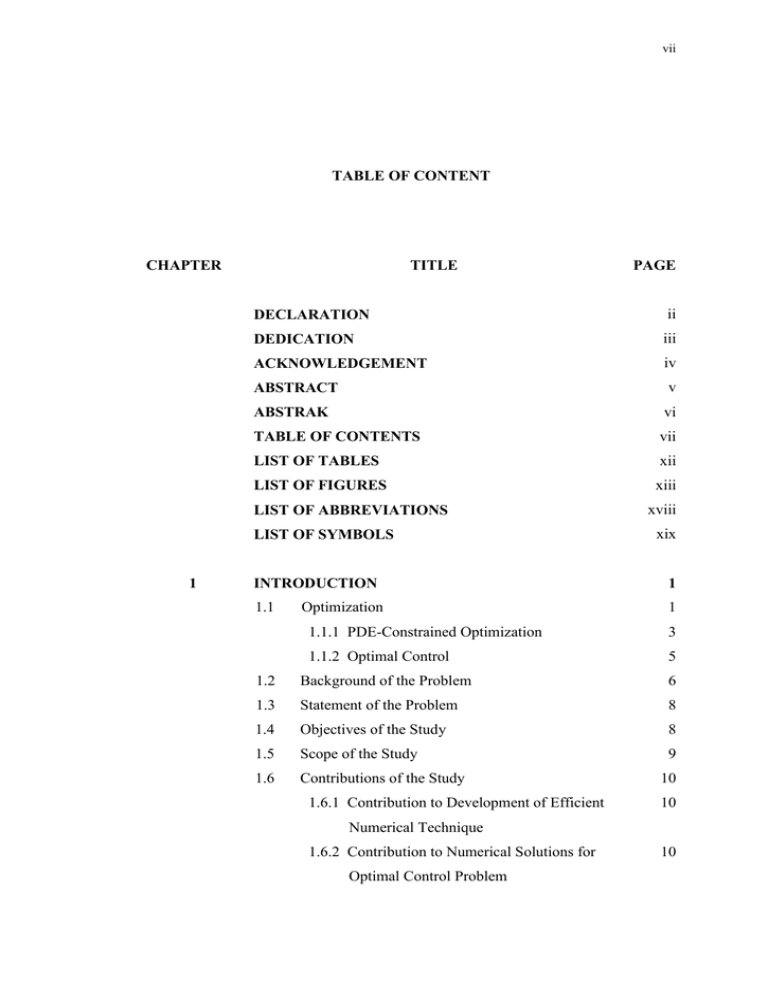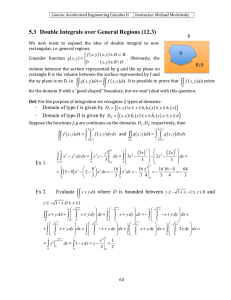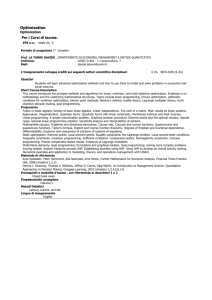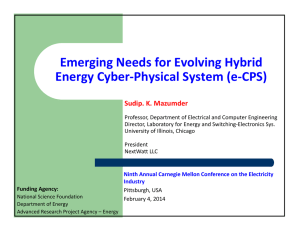ii iii iv
advertisement

vii TABLE OF CONTENT CHAPTER TITLE DECLARATION ii DEDICATION iii ACKNOWLEDGEMENT iv ABSTRACT v ABSTRAK vi TABLE OF CONTENTS vii LIST OF TABLES xii LIST OF FIGURES xiii LIST OF ABBREVIATIONS LIST OF SYMBOLS 1 PAGE xviii xix INTRODUCTION 1 1.1 1 Optimization 1.1.1 PDE-Constrained Optimization 3 1.1.2 Optimal Control 5 1.2 Background of the Problem 6 1.3 Statement of the Problem 8 1.4 Objectives of the Study 8 1.5 Scope of the Study 9 1.6 Contributions of the Study 1.6.1 Contribution to Development of Efficient 10 10 Numerical Technique 1.6.2 Contribution to Numerical Solutions for Optimal Control Problem 10 viii 1.6.3 Contribution to Defibrillation Process 1.7 2 Organization of the Thesis 10 12 LITERATURE REVIEW 13 2.1 Introduction 13 2.2 Anatomy and Physiology of the Heart 14 2.3 2.2.1 Location of the Heart 14 2.2.2 Layers of the Heart Wall 15 2.2.3 Chambers and Valves of the Heart 16 Cardiac Electrophysiology 17 2.3.1 Transmembrane Potential 19 2.3.2 Currents through Cellular Membrane 21 2.3.2.1 Capacitive Current 21 2.3.2.2 Ionic Currents 22 2.3.3 Electrical Circuit Model of Cellular 23 Membrane 2.4 Mathematical Modeling to Cardiac 24 Electrophysiology 2.4.1 The Bidomain Model 2.4.1.1 The Bidomain Equations 24 25 Derivation 2.4.1.2 The Ionic Models 28 2.4.1.3 Bidomain Boundary Conditions 29 2.4.2 The Monodomain Model 2.5 3 Summary NUMERICAL DISCRETIZATION FOR OPTIMAL 30 33 34 CONTROL PROBLEM OF MONODOMAIN MODEL 3.1 Introduction 34 3.2 Optimal Control Problem of Monodomain Model 36 3.3 Numerical Discretization for Optimal Control 37 Problem 3.3.1 First-Order Optimality System 38 ix 3.3.2 Operator Splitting Technique 3.3.2.1 Operator Splitting for 41 42 Monodomain Model 3.3.2.2 Operator Splitting for Optimal 44 Control Problem of Monodomain Model 3.3.3 Discretization of Optimality System 4 46 3.3.3.1 Discretization of Linear PDE 46 3.3.3.2 Discretization of Nonlinear ODEs 52 3.4 Mesh Generation 53 3.5 Summary 55 APPLICATION OF NONLINEAR CONJUGATE 56 GRADIENT METHODS 4.1 Introduction 56 4.2 Experiment Setup 60 4.3 Experiment Results 62 4.3.1 The Uncontrolled Solutions 63 4.3.2 Optimally Controlled Solutions Using 64 Classical Methods 4.3.2.1 The Polak-Ribière-Polyak (PRP) 67 Method 4.3.2.2 The Hestenes-Stiefel (HS) 70 Method 4.3.2.3 The Liu-Storey (LS) Method 72 4.3.2.4 Summary of Classical Methods 73 4.3.3 Optimally Controlled Solutions Using 74 Modified Methods 4.3.3.1 A Variant of the Polak-Ribière- 74 Polyak (VPRP) Method 4.3.3.2 A Variant of the Dai-Yuan (VDY) Method 77 x 4.3.3.3 The Modified Fletcher-Reeves 81 (MFR) Method 4.3.3.4 The Modified Dai-Yuan (MDY) 84 Method 4.3.3.5 Summary of Modified Methods 4.3.4 Optimally Controlled Solutions Using 86 87 Hybrid Methods 4.3.4.1 The Hybrid Hu-Storey (hHS) 88 Method 4.3.4.2 The Hybrid Dai-Yuan Zero 90 (hDYz) Method 4.3.4.3 The Hybrid Zhou (hZ) Method 92 4.3.4.4 The Hybrid Andrei (hA) Method 95 4.3.4.5 The Hybrid Ng-Rohanin (hNR) 98 Method 4.3.4.6 Summary of Hybrid Method 4.4 5 Summary EFFECTS OF CONTROL DOMAIN ON OPTIMAL 110 111 113 CONTROL PROBLEM OF MONODOMAIN MODEL 5.1 Introduction 113 5.2 Effects of Control Domain Position 114 5.2.1 Numerical Results for Test Case 1 116 5.2.2 Numerical Results for Test Case 2 120 5.2.3 Numerical Results for Test Case 3 125 5.2.4 Summary of Numerical Results for Test 129 Cases 1, 2 and 3 5.3 Effects of Control Domain Size 130 5.3.1 Numerical Results for Test Case 4 132 5.3.2 Numerical Results for Test Case 5 136 5.3.3 Numerical Results for Test Case 6 140 xi 5.3.4 Summary of Numerical Results for Test 145 Cases 4, 5 and 6 5.4 The Ideal Position and Size of the Control Domain 5.4.1 Numerical Results for Ideal Test Case 5.4.2 Summary of Numerical Results for Ideal 146 147 152 Test Case 5.5 6 Summary 154 CONCLUSIONS AND FUTURE WORKS 156 6.1 Introduction 156 6.2 Summary of Thesis Achievements 157 6.2.1 Improve Existing Numerical Solution 157 Technique 6.2.2 Efficient Optimization Methods 158 6.2.3 Development of New Hybrid Nonlinear 159 Conjugate Gradient Method 6.2.4 Observation of Significant Effects of 159 Control Domain 6.2.5 6.3 Ideal Control Domain Future Works 6.3.1 Extension to Three-Dimensional 160 161 161 Computational Domain REFERENCES 6.3.2 Extension to Longer Simulation Time 161 6.3.3 Extension to Finer Mesh Discretization 162 6.3.4 Extension to Bidomain Model 162 163 xii LIST OF TABLES TABLE NO. 2.1 TITLE Intracellular and extracellular concentrations of three PAGE 20 ions 4.1 Parameters used along this research 62 4.2 The detailed information on numerical results obtained 70 by HS method 4.3 Ranking of the classical methods 73 4.4 The detailed information on numerical results obtained 85 by MDY method 4.5 Ranking of the modified methods 86 4.6 The hybrid nonlinear conjugate gradient methods 87 4.7 The detailed information on numerical results obtained 92 by DY method 4.8 The detailed information on numerical results obtained 98 by hA method 4.9 Ranking of the hybrid methods 111 4.10 Ranking of the nonlinear conjugate gradient methods 112 5.1 Summary of numerical results 129 5.2 Summary of numerical results 145 5.3 Summary of numerical results for Test Case 1, 152 Test Case 6 and Ideal Test Case xiii LIST OF FIGURES FIGURE NO. TITLE 1.1 A classification of optimization problems 1.2 ICD that implanted in the chest of a patient (Taylor-Clarke PAGE 3 11 , 2008) 2.1 Location of the human heart (Saladin, 2012) 14 2.2 Three distinct layers in the heart wall (Saladin, 2012) 15 2.3 Internal structure of the heart (Katz, 2011) 17 2.4 Structure of cardiac myocytes (Morozova, 1978) 18 2.5 Structure of the gap junctions (Freeman, 2004) 18 2.6 Structure of cardiac tissue (Pennacchio et al., 2005) 19 2.7 A resting cardiac myocyte (Katz, 2011) 20 2.8 Electrical circuit model of cellular membrane (Keener 23 and Sneyd, 2009) 3.1 The five stages involved in solving OCPMM 34 3.2 Arrangement of stages for Chapter 3 to Chapter 6 35 3.3 Direct and indirect methods for discretizing the optimal 38 control problem 3.4 The concept of finite element method 47 3.5 (i) Parental triangular element and (ii) sub-divided 53 triangular elements 3.6 Different levels of mesh discretization 54 4.1 Overall solution algorithm using nonlinear conjugate 57 gradient methods 4.2 Computational domain and its sub-domains 60 4.3 Uncontrolled solutions at (i) 0.1 ms; (ii) 0.7 ms; (iii) 1.4 ms; 63 and (iv) 2.0 ms xiv 4.4 Minimum value at each optimization step using PRP method 68 for 2 ms simulation time 4.5 Norm of reduced gradient at each optimization step using 68 PRP method 4.6 Optimal state solutions at (i) 0.1 ms; (ii) 0.7 ms; (iii) 1.4 ms; 69 and (iv) 2.0 ms using PRP method 4.7 Minimum value at each optimization step using HS method 70 for 2 ms simulation time 4.8 Optimal state solutions at (i) 0.1 ms; (ii) 0.7 ms; (iii) 1.4 ms; 71 and (iv) 2.0 ms using HS method 4.9 Minimum value at each optimization step using LS method 72 for 2 ms simulation time 4.10 Norms of reduced gradient at each optimization step using 73 LS and PRP methods 4.11 Minimum value at each optimization step using VPRP 75 method for 2 ms simulation time 4.12 The values of conjugate gradient update parameter for VPRP 76 and PRP methods 4.13 Optimal state solutions at (i) 0.1 ms; (ii) 0.7 ms; (iii) 1.4 ms; 77 and (iv) 2.0 ms using VPRP method 4.14 Minimum values at each optimization step using VDY 79 methods for 2 ms simulation time 4.15 Norms of reduced gradient at each optimization step using 79 VDY methods 4.16 Optimal state solutions at (i) 0.1 ms; (ii) 0.7 ms; (iii) 1.4 ms; 80 and (iv) 2.0 ms using VDY method 4.17 Minimum value at each optimization step using MFR method 82 for 2 ms simulation time 4.18 Norms of reduced gradient at each optimization step using 82 MFR and PRP methods 4.19 Optimal state solutions at (i) 0.1 ms; (ii) 0.7 ms; (iii) 1.4 ms; 83 and (iv) 2.0 ms using MFR method 4.20 Minimum value at each optimization step using MDY method for 2 ms simulation time 84 xv 4.21 Norm of reduced gradient at each optimization step using 86 MDY method 4.22 Minimum value at each optimization step using hHS method 88 for 2 ms simulation time 4.23 Norm of reduced gradient at each optimization step using 89 hHS method 4.24 Optimal state solutions at (i) 0.1 ms; (ii) 0.7 ms; (iii) 1.4 ms; 90 and (iv) 2.0 ms using hHS method 4.25 Minimum value at each optimization step using hDYz method 91 for 2 ms simulation time 4.26 Minimum value at each optimization step using hZ method 93 for 2 ms simulation time 4.27 Values of conjugate gradient update parameter for hHS 94 method 4.28 Values of conjugate gradient update parameter for hDYz 94 method 4.29 Values of conjugate gradient update parameter for hZ 95 method 4.30 Minimum value at each optimization step using hA method 97 for 2 ms simulation time 4.31 Minimum value at each optimization step using hNR method 108 for 2 ms simulation time 4.32 Norm of reduced gradient at each optimization step using 109 hNR and hZ methods 4.33 Optimal state solutions at (i) 0.1 ms; (ii) 0.7 ms; (iii) 1.4 ms; 110 and (iv) 2.0 ms using hNR method 5.1 The positions of (i) observation domain and (ii) control 114 domain for Test Case 1 5.2 The positions of (i) observation domain and (ii) control 115 domain for Test Case 2 5.3 The positions of (i) observation domain and (ii) control 116 domain for Test Case 3 5.4 Minimum value at each optimization step using VDY method for Test Case 1 117 xvi 5.5 Norm of reduced gradient at each optimization step using 117 VDY method for Test Case 1 5.6 Optimal state solutions at (i) 0.1 ms; (ii) 0.7 ms; (iii) 1.4 ms; 118 and (iv) 2.0 ms for Test Case 1 5.7 Optimal extracellular currents at (i) 0.1 ms; (ii) 0.7 ms; 120 (iii) 1.4 ms; and (iv) 2.0 ms for Test Case 1 5.8 Minimum value at each optimization step using VDY 121 method for Test Case 2 5.9 Norm of reduced gradient at each optimization step using 122 VDY method for Test Case 2 5.10 Optimal state solutions at (i) 0.1 ms; (ii) 0.7 ms; (iii) 1.4 ms; 123 and (iv) 2.0 ms for Test Case 2 5.11 Optimal extracellular currents at (i) 0.1 ms; (ii) 0.7 ms; 124 (iii) 1.4 ms; and (iv) 2.0 ms for Test Case 2 5.12 Minimum value at each optimization step using VDY 125 method for Test Case 3 5.13 Norm of reduced gradient at each optimization step using 126 VDY method for Test Case 3 5.14 Optimal state solutions at (i) 0.1 ms; (ii) 0.7 ms; (iii) 1.4 ms; 127 and (iv) 2.0 ms for Test Case 3 5.15 Optimal extracellular currents at (i) 0.1 ms; (ii) 0.7 ms; 128 (iii) 1.4 ms; and (iv) 2.0 ms for Test Case 3 5.16 The positions of (i) observation domain and (ii) control 130 domain for Test Case 4 5.17 The positions of (i) observation domain and (ii) control 131 domain for Test Case 5 5.18 The positions of (i) observation domain and (ii) control 132 domain for Test Case 6 5.19 Minimum value at each optimization step using VDY 133 method for Test Case 4 5.20 Norm of reduced gradient at each optimization step using 134 VDY method for Test Case 4 5.21 Optimal state solutions at (i) 0.1 ms; (ii) 0.7 ms; (iii) 1.4 ms; and (iv) 2.0 ms for Test Case 4 135 xvii 5.22 Optimal extracellular currents at (i) 0.1 ms; (ii) 0.7 ms; 136 (iii) 1.4 ms; and (iv) 2.0 ms for Test Case 4 5.23 Minimum value at each optimization step using VDY 137 method for Test Case 5 5.24 Norm of reduced gradient at each optimization step using 138 VDY method for Test Case 5 5.25 Optimal state solutions at (i) 0.1 ms; (ii) 0.7 ms; (iii) 1.4 ms; 139 and (iv) 2.0 ms for Test Case 5 5.26 Optimal extracellular currents at (i) 0.1 ms; (ii) 0.7 ms; 140 (iii) 1.4 ms; and (iv) 2.0 ms for Test Case 5 5.27 Minimum value at each optimization step using VDY 141 method for Test Case 6 5.28 Norm of reduced gradient at each optimization step using 142 VDY method for Test Case 6 5.29 Optimal state solutions at (i) 0.1 ms; (ii) 0.7 ms; (iii) 1.4 ms; 143 and (iv) 2.0 ms for Test Case 6 5.30 Optimal extracellular currents at (i) 0.1 ms; (ii) 0.7 ms; 144 (iii) 1.4 ms; and (iv) 2.0 ms for Test Case 6 5.31 The positions of (i) observation domain and (ii) control 147 domain for Ideal Test Case 5.32 Minimum value at each optimization step using VDY 148 method for Ideal Test Case 5.33 Norm of reduced gradient at each optimization step using 149 VDY method for Ideal Test Case 5.34 Optimal state solutions at (i) 0.1 ms; (ii) 0.7 ms; (iii) 1.4 ms; 150 and (iv) 2.0 ms for Ideal Test Case 5.35 Optimal extracellular currents at (i) 0.1 ms; (ii) 0.7 ms; (iii) 1.4 ms; and (iv) 2.0 ms for Ideal Test Case 151 xviii LIST OF ABBREVIATIONS CD - Conjugate Descent DY - Dai-Yuan FR - Fletcher-Reeves HS - Hestenes-Stiefel hA - Hybrid Andrei hDY - Hybrid Dai-Yuan hDYz - Hybrid Dai-Yuan zero hHS - Hybrid Hu-Storey hNR - Hybrid Ng-Rohanin hZ - Hybrid Zhou ICD - Implantable cardioverter defibrillator LS - Liu-Storey MBFGS - Modified Broyden-Fletcher-Goldfarb-Shanno MDY - Modified Dai-Yuan MFR - Modified Fletcher-Reeves OCPMM - Optimal control problem of monodomain model ODE - Ordinary differential equation PDE - Partial differential equation PRP - Polak-Ribière-Polyak VDY - Variant of the Dai-Yuan VPRP - Variant of the Polak-Ribière-Polyak xix LIST OF SYMBOLS D - Conductivity of the medium E - Electrical field F - Positive parameter F̂ - Faraday’s constant f x - Objective function f V , w - Vector-value functions f y, u - Cost functional G - Total number of global nodal points g x - Function for equality constraint g yt , ut , t - Continuously differentiable function h x - Function for inequality constraint I yt , ut , t - Continuously differentiable function J - Current J V , I e - Cost functional Ĵ I e - Reduced cost functional K - Stiffness matrix k - Optimization iteration L - Positive parameter M - Mass matrix N - Neighborhoods of level set S n - Index of the time-step px, t - Adjoint variable Q - Charge across the capacitor qx, t - Adjoint variable xx R̂ - Universal gas constant S - Level set T - Final simulation time Tˆ - Absolute temperature t - Time u t - Control variable V - Transmembrane potential w - Ionic current variables x - Decision variable y t - State variable y - State equations - Regularization parameter - Surface-to-volume ratio of the cellular membrane - Positive parameter - Positive parameter - Vector normal to the boundary - Scalar parameter - Constant scalar - Scalar parameter - Positive parameter - Scalar potential - Univariate function - Scalar parameter - Computational domain - Nonnegative parameter - Nonnegative parameter - Lagrange functional Ca - Calcium Dil,e - Conductivity in the fiber direction Din,e - Conductivity in the cross-sheet direction Dit,e - Conductivity in the sheet direction L 2+ xxi dk - Search direction - Potassium Na - Sodium k - Step-length k - Conjugate gradient update parameter k - Hybridization parameter A1 - Operator A2 - Operator Cm - Membrane capacitance per unit area c1 - Positive parameter c2 - Positive parameter c3 - Positive parameter c4 - Positive parameter De - Extracellular conductivity tensor Di - Intracellular conductivity tensor Ex - Nernst potential for ion x IC - Capacitive current Ie - Extracellular current I ion - Total ionic currents Im - Transmembrane current per unit area Ix - Ionic current for ion x Je - Extracellular current Ji - Intracellular current Nj - Interpolation functions rx - Channel resistance for ion x Vj - Time dependent nodal variables - Transmembrane potential in the observation domain Vp - Plateau potential Vth - Threshold potential K+ + V o xxii zx - Valence of the ion x e - Extracellular potential i - Intracellular potential c - Control domain c1 - First control domain c2 - Second control domain ~ c1 - Neighborhoods of first control domain ~ c2 - Neighborhoods of second control domain exi - Excitation domain o - Observation domain - Lipschitz boundary - Extracellular concentration of the ion x - Intracellular concentration of the ion x - Euclidean norm of vectors t1 - Local time-step for the linear PDE t 2 - Local time-step for the nonlinear ODEs Ĵ I e - Reduced gradient xe xi


